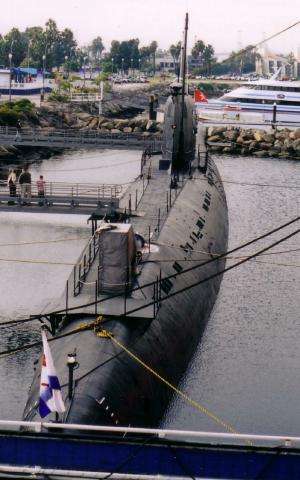Soviet submarine B-427
B-427 was a Project 641 (Foxtrot-class) diesel-electric attack submarine of the Soviet Navy. The "B" (actually "Б") in her designation stands for большая (bolshaya, "large"). Commissioned in 1971, the submarine operated with the Russian Pacific Fleet until decommissioning in 1994. The boat was sold to a group of Australian businessmen, who converted her into a museum vessel, which was placed on display at the Australian National Maritime Museum (under the name Foxtrot-540) from 1995 until 1998, then at Long Beach, California (under the name Podvodnaya Lodka B-427 Scorpion) in 1998.
 B-427, on display in Long Beach, California | |
| History | |
|---|---|
| Name: | B-427 |
| Laid down: | 10 April 1971 |
| Launched: | 22 June 1971 |
| Commissioned: | 4 December 1971 |
| Decommissioned: | 1994 |
| Stricken: | 1994 |
| Status: | Museum ship; shut down as of 2016 |
| General characteristics | |
| Class and type: | Foxtrot-class submarine |
| Displacement: |
|
| Length: | 299 ft 6 in (91.29 m) |
| Beam: | 24 ft 7 in (7.49 m) |
| Draft: | 20 ft (6.1 m) |
| Propulsion: |
|
| Speed: |
|
| Range: |
|
| Endurance: | 3–5 days submerged |
| Test depth: | 270–280 m (890–920 ft) |
| Complement: | 12 officers, 10 warrants, 56 seamen |
| Armament: |
|
As of July 2016, the submarine is closed to the public.
Service history
Her keel was laid down on 10 April 1971 at Sudomekh Shipyard of Leningrad. It was launched on 22 June 1971 and commissioned on 4 December 1994.
For twenty-two years B-427 patrolled the Pacific, protecting the ballistic missile submarine bastions of the Pacific Fleet while based out of Vladivostok, Russia with the exception of a few temporary postings as part of the Soviet Submarine Squadron that was for a time based at the former US Navy base at Cam Ranh Bay, Vietnam. Such postings were normally for a period of between 8 and 12 months before returning to Vladivostok.
In 1989, B-427 was returning to Vladivostok from Vietnam when it ran into a typhoon. A mechanical breakdown that could not be fixed in time prevented the sub from diving. The storm battered the boat, destroying the light hull and damaging the ballast tanks and high pressure air bottles. B-427 was taken back to Vladivostok where it was repaired and refitted with a new light hull.
Decommissioning and preservation
The submarine was decommissioned by the Russian Navy in December 1994.[1] She was one of the last three Foxtrot-class submarines to serve in the Russian Pacific Fleet.[1] The boat was acquired by a group of Australian businessmen on a three-year lease purchase contract, and was towed from Vladivostok on 25 July 1995.[1][2] En route to Sydney, the tow company claimed that the deal for the Russian Navy to cover the cost of the tow was invalid, and claimed that A$150,000 in towing expenses was required.[2] The submarine arrived in Sydney on 31 August, and after some modifications, was loaned to the Australian National Maritime Museum for display as a museum vessel under the designation "Foxtrot-540" (the submarine's last pennant number while in service).[1] As the submarine was still the property of the Russian Navy for the duration of the lease, an Australian ex-submariner was commissioned into the Russian Navy to command and look after Foxtrot-540, with the boat's former engineering officer assisting.[1] The submarine was in near-operational condition; the diesel generators and electrical storage system, ballast tanks, and hotel load equipment were functional, and Russian personnel travelled to Australia to teach museum staff about maintenance and operation of the boat.[1] Foxtrot-540 spent three years berthed at the museum, attracting over 700,000 visitors during this period (including intelligence analysts from multiple nations during the first weeks on display).[1]
In May 1998, the submarine was loaded onto a heavy lift ship and relocated to Long Beach, California,[1] sailing from Sydney on 31 May and arriving on 25 June. On arrival, she was berthed next to RMS Queen Mary, and opened to the public on 14 July under the designation "Podvodnaya Lodka B-427 Scorpion".[3] On 19 April 2011, the company operating Queen Mary (Delaware North) announced that they had acquired Scorpion, and were planning to increase attendance at both attractions through combined ticketing and joint marketing campaigns.[3] Urban Commons took over the lease of the Queen Mary and the Scorpion in April 2016. The Scorpion Submarine is owned by NEWCO Pty Ltd and is on a long term lease to Urban Commons.[4]
In November 2012, the vessel was discovered to have flooding and as a result was listing 24 degrees to the starboard side.[5] It was closed to the public in 2015, by which time the pressure hull had ruptured and raccoons had taken up residence on board. In 2019, NEWCO Pty Ltd announced plans to sell it.
Citation
- Walsh, Soviet sub penetrates Sydney Harbour!, p. 105
- Hyman & Dunsford, How to Value a Submarine, p. 223
- Target News Service, The Queen Mary and Soviet 'Scorpion' Sub Join Forces
- MARTÍN, HUGO (2019-11-19). "That Soviet submarine next to the Queen Mary is being sold to an anonymous buyer". [ Los Angeles Times]]. Retrieved 2019-11-20.
- "Water Flooding On Scorpion Submarine Causes Listing". Long Beach Post. Retrieved 2012-11-26.
See also
- B-39, a Foxtrot on display in San Diego, California.
References
- Hyman, Rodney; Dunsford, Cameron (2000). "How to Value a Submarine". Australian Property Journal (August 2000): 223–5.
- "The Queen Mary and Soviet 'Scorpion' Sub Join Forces". Targeted News Service. 19 April 2011.
- Walsh, Don (April 1998). "Soviet sub penetrates Sydney Harbour!". Proceedings. United States Naval Institute. 124 (4): 105.